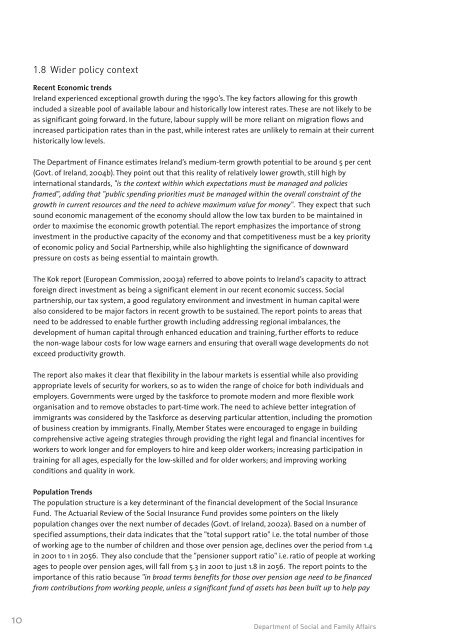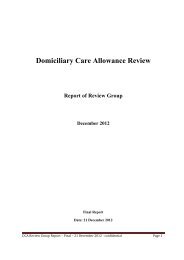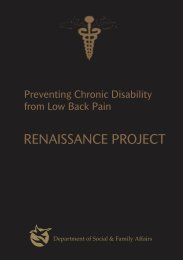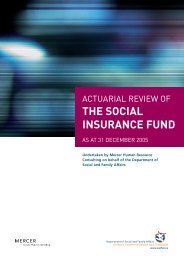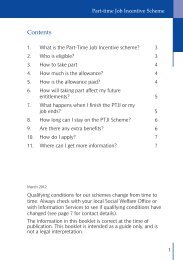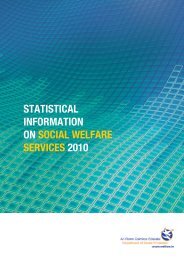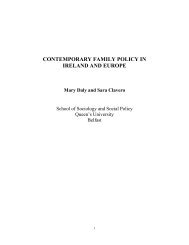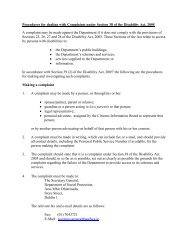Developing a Fully Inclusive Social Insurance Model - Welfare.ie
Developing a Fully Inclusive Social Insurance Model - Welfare.ie
Developing a Fully Inclusive Social Insurance Model - Welfare.ie
You also want an ePaper? Increase the reach of your titles
YUMPU automatically turns print PDFs into web optimized ePapers that Google loves.
1.8 Wider policy contextRecent Economic trendsIreland exper<strong>ie</strong>nced exceptional growth during the 1990’s. The key factors allowing for this growthincluded a sizeable pool of available labour and historically low interest rates. These are not likely to beas significant going forward. In the future, labour supply will be more reliant on migration flows andincreased participation rates than in the past, while interest rates are unlikely to remain at their currenthistorically low levels.The Department of Finance estimates Ireland’s medium-term growth potential to be around 5 per cent(Govt. of Ireland, 2004b). They point out that this reality of relatively lower growth, still high byinternational standards, "is the context within which expectations must be managed and polic<strong>ie</strong>sframed", adding that "public spending priorit<strong>ie</strong>s must be managed within the overall constraint of thegrowth in current resources and the need to ach<strong>ie</strong>ve maximum value for money". They expect that suchsound economic management of the economy should allow the low tax burden to be maintained inorder to maximise the economic growth potential. The report emphasizes the importance of stronginvestment in the productive capacity of the economy and that competitiveness must be a key priorityof economic policy and <strong>Social</strong> Partnership, while also highlighting the significance of downwardpressure on costs as being essential to maintain growth.The Kok report (European Commission, 2003a) referred to above points to Ireland’s capacity to attractforeign direct investment as being a significant element in our recent economic success. <strong>Social</strong>partnership, our tax system, a good regulatory environment and investment in human capital werealso considered to be major factors in recent growth to be sustained. The report points to areas thatneed to be addressed to enable further growth including addressing regional imbalances, thedevelopment of human capital through enhanced education and training, further efforts to reducethe non-wage labour costs for low wage earners and ensuring that overall wage developments do notexceed productivity growth.The report also makes it clear that flexibility in the labour markets is essential while also providingappropriate levels of security for workers, so as to widen the range of choice for both individuals andemployers. Governments were urged by the taskforce to promote modern and more flexible workorganisation and to remove obstacles to part-time work. The need to ach<strong>ie</strong>ve better integration ofimmigrants was considered by the Taskforce as deserving particular attention, including the promotionof business creation by immigrants. Finally, Member States were encouraged to engage in buildingcomprehensive active ageing strateg<strong>ie</strong>s through providing the right legal and financial incentives forworkers to work longer and for employers to hire and keep older workers; increasing participation intraining for all ages, especially for the low-skilled and for older workers; and improving workingconditions and quality in work.Population TrendsThe population structure is a key determinant of the financial development of the <strong>Social</strong> <strong>Insurance</strong>Fund. The Actuarial Rev<strong>ie</strong>w of the <strong>Social</strong> <strong>Insurance</strong> Fund provides some pointers on the likelypopulation changes over the next number of decades (Govt. of Ireland, 2002a). Based on a number ofspecif<strong>ie</strong>d assumptions, their data indicates that the "total support ratio" i.e. the total number of thoseof working age to the number of children and those over pension age, declines over the period from 1.4in 2001 to 1 in 2056. They also conclude that the "pensioner support ratio" i.e. ratio of people at workingages to people over pension ages, will fall from 5.3 in 2001 to just 1.8 in 2056. The report points to theimportance of this ratio because "in broad terms benefits for those over pension age need to be financedfrom contributions from working people, unless a significant fund of assets has been built up to help pay10Department of <strong>Social</strong> and Family Affairs


